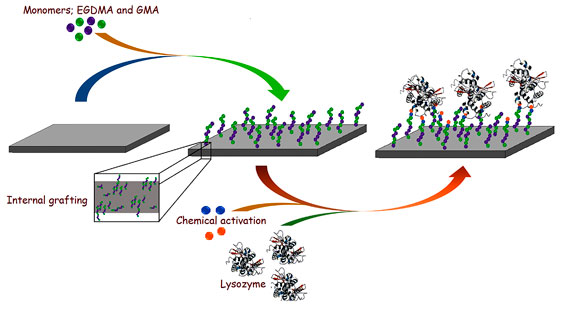Crossref Citations
This article has been cited by the following publications. This list is generated based on data provided by
Crossref.
Flores-Rojas, G. G.
López-Saucedo, F.
Quezada-Miriel, M.
and
Bucio, E.
2018.
Grafting of glycerol methacrylate onto silicone rubber using γ-rays: derivatization to 2-oxoethyl methacrylate and immobilization of lysozyme.
MRS Communications,
Vol. 8,
Issue. 1,
p.
199.
Flores-Rojas, G. G.
López-Saucedo, F.
López-Barriguete, J. E.
Isoshima, T.
Luna-Straffon, M.
and
Bucio, E.
2018.
Polypropylene films modified by grafting-from of ethylene glycol dimethacrylate/glycidyl methacrylate using γ-rays and antimicrobial biofunctionalization by Schiff bases.
MRS Communications,
Vol. 8,
Issue. 1,
p.
168.
Velazco‐Medel, Marlene A.
Camacho‐Cruz, Luis A.
and
Bucio, Emilio
2020.
Modification of relevant polymeric materials for medical applications and devices.
MEDICAL DEVICES & SENSORS,
Vol. 3,
Issue. 6,
Yang, Wenli
Zhang, Nan
Wang, Qiang
Wang, Ping
and
Yu, Yuanyuan
2020.
Development of an eco-friendly antibacterial textile: lysozyme immobilization on wool fabric.
Bioprocess and Biosystems Engineering,
Vol. 43,
Issue. 9,
p.
1639.
Velazco-Medel, M.A.
Camacho-Cruz, L.A.
and
Bucio, E.
2020.
Modification of PDMS with acrylic acid and acrylic acid/ethylene glycol dimethacrylate by simultaneous polymerization assisted by gamma radiation.
Radiation Physics and Chemistry,
Vol. 171,
Issue. ,
p.
108754.
Dwevedi, Alka
and
Dwivedi, Raman
2021.
Polymeric Supports for Enzyme Immobilization.
p.
27.
López-Saucedo, Felipe
López-Barriguete, Jesús Eduardo
Flores-Rojas, Guadalupe Gabriel
Gómez-Dorantes, Sharemy
and
Bucio, Emilio
2021.
Polypropylene Graft Poly(methyl methacrylate) Graft Poly(N-vinylimidazole) as a Smart Material for pH-Controlled Drug Delivery.
International Journal of Molecular Sciences,
Vol. 23,
Issue. 1,
p.
304.
Vázquez, E.
Duarte, L.
Lopéz-Saucedo, F.
Flores-Rojas, G. G.
and
Bucio, E.
2021.
Advanced Antimicrobial Materials and Applications.
p.
321.
Anastas, Paul T.
Rodriguez, Alina
de Winter, Tamara M.
Coish, Philip
and
Zimmerman, Julie B.
2021.
A review of immobilization techniques to improve the stability and bioactivity of lysozyme.
Green Chemistry Letters and Reviews,
Vol. 14,
Issue. 2,
p.
302.
Sharma, Vivek K.
Sharma, Minaxi
Usmani, Zeba
Pandey, Ashok
Singh, Brahma N.
Tabatabaei, Meisam
and
Gupta, Vijai Kumar
2022.
Tailored enzymes as next-generation food-packaging tools.
Trends in Biotechnology,
Vol. 40,
Issue. 8,
p.
1004.
Flores-Rojas, G.G.
López-Saucedo, F.
Vázquez, E.
Vera-Graziano, R.
Buendía-González, L.
Mendizábal, E.
and
Bucio, E.
2025.
Antimicrobial Materials and Coatings.
p.
177.
Chen, Shuhui
Zhao, Dan
Mu, Qingdi
Sun, Jian
Liu, Huiqiang
Wang, Lele
and
Ren, Jizhong
2025.
Pebax thin film composite membranes for CO2 separation with the assistance of plasma treatment and Pluronic®F127 impregnation.
Separation and Purification Technology,
Vol. 355,
Issue. ,
p.
129740.
